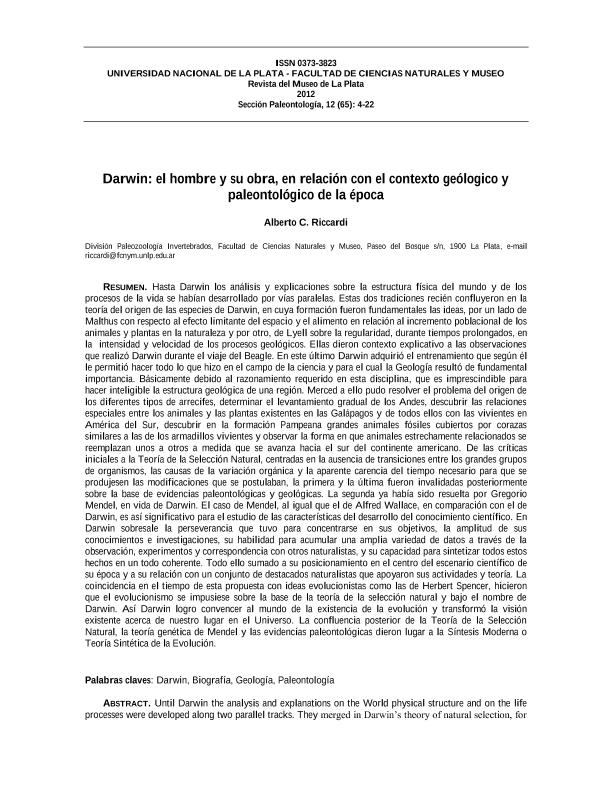Mostrar el registro sencillo del ítem
dc.contributor.author
Riccardi, Alberto Carlos

dc.date.available
2023-05-29T17:34:19Z
dc.date.issued
2012-12
dc.identifier.citation
Riccardi, Alberto Carlos; Darwin: el hombre, y su obra en el contexto geológico y paleontológico de la época; Universidad Nacional de La Plata. Facultad de Ciencias Naturales y Museo; Revista del Museo de La Plata; 12; 65; 12-2012; 4-22
dc.identifier.issn
0373-3823
dc.identifier.uri
http://hdl.handle.net/11336/198841
dc.description.abstract
Hasta Darwin los análisis y explicaciones sobre la estructura física del mundo y de los procesos de la vida se habían desarrollado por vías paralelas. Estas dos tradiciones recién confluyeron en la teoría del origen de las especies de Darwin, en cuya formación fueron fundamentales las ideas, por un lado de Malthus y por otro, de Lyell sobre la regularidad, durante tiempos prolongados, en la intensidad y velocidad de los procesos geológicos. De las críticas iniciales a la Teoría de la Selección Natural, centradas en la ausencia de transiciones entre los grandes grupos de organismos, las causas de la variación orgánica y la aparente carencia del tiempo necesario para que se produjesen las modificaciones que se postulaban, la primera y la última fueron invalidadas posteriormente sobre la base de evidencias paleontológicas y geológicas. La segunda ya había sido resuelta por Gregorio Mendel, en vida de Darwin. La confluencia posterior de la Teoría de la Selección Natural, la teoría genética de Mendel y las evidencias paleontológicas dieron lugar a la Síntesis Moderna o Teoría Sintética de la Evolución.
dc.description.abstract
Until Darwin the analysis and explanations on the World physical structure and on the life processes were developed along two parallel tracks. They merged in Darwin’s theory of natural selection, for which were fundamental the ideas, on one side of Malthus with regard to the limitation imposed by space and food in relation to the increase of animal and plant populations in nature, and on the other of Lyell, on the long regularity in the intensity and velocity of geological processes. These ideas gave an explicative context to the observations recorded by Darwin during the voyage of the Beagle. In this trip Darwin acquired the training on which he could accomplish all he did in science, and for which Geology was important due to the reasoning it requires, basically to make intelligible the structure of any region. Thus, Darwin could offer sound explanations for the origin of coral reefs, the intermittent elevation of the Andes, the singular relations of the animals and plants inhabiting the several island of the Galapagos archipelago, and of all great-fossil animals covered with armour like that of the existing armadillos, and to the manner in which closely allied animals replace one another in proceeding southwards over the South American continent. Of the initial criticisms to the Theory of Natural Selection, centered in the absence of transitional forms between large animal groups, the origin of the organic variation and the apparent lack of the necessary time to produce the proposed changes, the first and last were later disregarded on the basis of paleontological and geological evidences. The second was resolved by Mendel, in Darwin’s life time. Circumstances surrounding the relative success of Mendel and Wallace contributions, especially in comparison to that of Darwin, are significant to understand the development of scientific knowledge. Outstanding features in Darwin were his perseverance to concentrate in his goals, the amplitude of his knowledge and research, his foresight of never letting exception pass unnoticed, his industry to gather a wide variety of data through observation, experiment, and exchange of information with other naturalists and his capacity to synthesize all these facts in a coherent whole. All these qualities were favored by his positioning at the center of the scientific scenery of his time and his acquaintance with a number of outstanding naturalists that supported his activities and his theory of natural selection. The coincidence of this theory with Herbert Spencer evolutionist ideas, resulted in the acceptance of evolutionism, but as exposed in the theory of Natural Selection and under Darwin’s name. On that basis Darwin could convince the World about the existence of evolution and thus he changed the vision we have of our place in the Universe. The subsequent merging of Theory of Natural Selection, Mendelian genetics and paleontological evidences resulted in the Modern Synthesis or Synthetic Theory of Evolution.
dc.format
application/pdf
dc.language.iso
spa
dc.publisher
Universidad Nacional de La Plata. Facultad de Ciencias Naturales y Museo

dc.rights
info:eu-repo/semantics/openAccess
dc.rights.uri
https://creativecommons.org/licenses/by-nc-sa/2.5/ar/
dc.subject
Darwin
dc.subject
Biografía
dc.subject
Geología
dc.subject
Paleontología
dc.subject.classification
Geología

dc.subject.classification
Ciencias de la Tierra y relacionadas con el Medio Ambiente

dc.subject.classification
CIENCIAS NATURALES Y EXACTAS

dc.title
Darwin: el hombre, y su obra en el contexto geológico y paleontológico de la época
dc.type
info:eu-repo/semantics/article
dc.type
info:ar-repo/semantics/artículo
dc.type
info:eu-repo/semantics/publishedVersion
dc.date.updated
2023-05-29T13:52:39Z
dc.journal.volume
12
dc.journal.number
65
dc.journal.pagination
4-22
dc.journal.pais
Argentina

dc.journal.ciudad
La Plata
dc.description.fil
Fil: Riccardi, Alberto Carlos. Universidad Nacional de La Plata. Facultad de Ciencias Naturales y Museo. Departamento de Paleontología Invertebrados; Argentina. Consejo Nacional de Investigaciones Científicas y Técnicas. Centro Científico Tecnológico Conicet - La Plata; Argentina
dc.journal.title
Revista del Museo de La Plata
dc.relation.alternativeid
info:eu-repo/semantics/altIdentifier/url/https://publicaciones.fcnym.unlp.edu.ar/rmlp/article/view/2309
Archivos asociados
